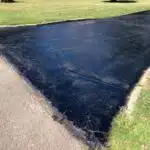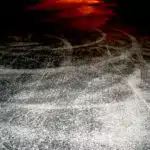Oil stains on your driveway can be a frustrating and unsightly problem. Whether caused by an oil leak from your car or spillage during routine maintenance, these stains can be tough to remove without the right tools and techniques. Fortunately, there are several effective methods you can use to get rid of oil stains and restore the look of your driveway.
As a professional cleaning expert, I have seen firsthand how oil stains can detract from the overall appearance of a property. In this article, I will share my expertise on how to get oil stains off of a driveway. From simple household remedies to specialized cleaning products, I will explore a variety of strategies that you can use to tackle even the most stubborn oil stains. By following these tips, you’ll be able to not only improve the aesthetics of your driveway but also increase its lifespan and prevent potential hazards such as slips and falls.
Understanding The Causes Of Oil Stains On Your Driveway
Oil stains on your driveway can be an unsightly mess that is difficult to remove. They not only ruin the appearance of your property but also pose a safety risk as they can be slippery and cause accidents. The causes of oil stains are numerous, ranging from vehicle leaks to accidental spills during routine maintenance. These oils seep into the pores of the concrete, making it hard to get rid of them completely.
Preventing oil stains is essential in avoiding this problem altogether. Regular cleaning and maintenance of vehicles can minimize leaks and spills, which go a long way in keeping your driveway clean. Using drip pans or trays when carrying out vehicle maintenance can help capture any excess oils that may spill, preventing them from soaking into concrete. Similarly, placing absorbent materials such as cat litter or sand over oil stains as soon as possible after a spill will help prevent the oil from penetrating deeper into the concrete.
Identifying the type of oil stain is crucial in determining the best method for removing it effectively. Different types of oils require different cleaning solutions and techniques for removal. Therefore, before embarking on any cleaning process, it’s important to identify whether it’s fresh or old oil, what kind of vehicle caused the stain, and how long ago it was deposited on your driveway. With this information at hand, you’ll be able to choose the right products and tools needed for successful removal without causing further damage to your driveway surface.
Identifying The Type Of Oil Stain
- Differentiating between oil and other stains is important in order to properly remove them from a driveway.
- Identifying the source of the stain, such as motor oil or cooking oil, is necessary to understand the type of stain and the best method to treat it.
- To determine the age of the stain, one must consider the type of oil, the environment, and the duration of exposure.
- Oil stains can often be distinguished from other types of stains by their dark, glossy appearance and strong odor.
- Motor oil stains tend to be thicker and more difficult to remove than cooking oil stains.
- The longer the oil is left to sit on the driveway, the harder it will be to remove it.
Differentiating Between Oil And Other Stains
Differentiating between oil and other stains on a driveway is essential to determine the appropriate cleaning method. Oil stains can be caused by different types of oils, such as motor oil, cooking oil or lubricants. Identifying the type of oil stain can help differentiate it from other stains like rust or tire marks. Differentiating techniques may include observing the color, texture and smell of the stain.
One of the best practices to differentiate between oil and other stains is to look for a greasy texture and an oily smell on the affected surface. Motor oil appears in blackish brown color while cooking oil has a yellowish tint that appears greasy. On the other hand, rust stains are reddish-brown with an abrasive texture. Tire marks are usually black or gray with a rubbery texture that feels sticky when touched.
Differentiating between oil and other stains on a driveway requires keen observation skills to identify the characteristics unique to each type of stain accurately. It is vital to choose an appropriate cleaning product based on our identification process before attempting to remove any stain from your driveway surface. Proper identification will save you time, effort and money when dealing with tough stains like motor oil or grease spills on your driveway surface.
Identifying The Source Of The Stain
Identifying the source of the stain is another crucial step in effectively removing oil stains from a driveway. While identifying the type of oil stain is essential, determining its source can prevent future occurrences. Identifying potential sources of oil spills and leaks, such as vehicles or equipment, can help implement prevention measures for oil stains.
Prevention measures for oil stains include ensuring proper maintenance of vehicles and equipment to avoid leaks and spills that may cause stains on your driveway surface. Additionally, laying an absorbent material like cat litter or sand on areas where oil spills are likely to occur can prevent the stain from seeping into your driveway surface. Regularly cleaning these areas will also help minimize any damage caused by oil spills and reduce the chance of stubborn stains forming.
Identifying the source of the stain is just as critical as identifying its type when dealing with oil stains on your driveway. With proper identification and prevention measures in place, you can save time, effort and money while protecting your driveway surface from unsightly stains caused by motor oils or other types of oils.
Determine The Age Of The Stain
Determining the age of the stain is another vital step in effectively removing oil stains from a driveway. Testing stain age can help you determine the best approach to take when removing old stains. Fresh oil stains are easier to clean than old ones, and they require less time and effort to remove.
To test the age of an oil stain on your driveway, pour a small amount of water onto it. If the water beads up and does not penetrate the surface, then chances are that the stain is relatively new. However, if the water quickly seeps into the stain and spreads out, then it is probably an old one. Old stains often require more aggressive cleaning methods to remove them completely.
Removing old stains can be challenging, but it is possible with proper techniques and equipment. It may involve using specialized cleaners or applying a poultice to draw out the remaining oil from deep within your driveway surface. Determining the age of a stain can help you choose which method to use for optimal results. With patience and persistence, you can successfully remove even stubborn old oil stains from your driveway surface.
Preparing Your Driveway For Cleaning
Before diving into the cleaning process, it is essential to prepare your driveway. First and foremost, ensure that you have the proper protective gear, such as rubber gloves and safety goggles. These items will protect your skin and eyes from any potential harm that may come from handling cleaning chemicals or debris.
Next, consider sealing your driveway after cleaning it thoroughly. Driveway sealing is an excellent way to prevent future oil stains from occurring. It forms a protective layer over the surface, making it easier to clean up spills in the future. A well-sealed driveway will also resist damage caused by weather elements such as UV rays or water.
Lastly, take a few moments to clear any debris on your driveway before starting the cleaning process. Remove any loose leaves or sticks that may be present on the surface of your driveway. This will make it easier for you to identify all the oil stains present on your driveway’s surface and ensure that they are cleaned effectively.
Now that you have prepared your driveway adequately let us move onto an effective way of removing oil stains – using cat litter!
Using Cat Litter To Absorb Oil Stains
Cat litter is a highly effective and affordable method for absorbing oil stains from your driveway. However, if you are unable to use cat litter, there are alternative materials that can be used. For instance, sand, sawdust or baking soda can also absorb oil stains on your driveway.
Once the oil is absorbed by the cat litter, it is important to dispose of it properly. This is because the cat litter will now be soaked with oil and cannot be disposed of in your regular trash bin. Instead, it should be placed in a plastic bag and taken to your local hazardous waste disposal facility. It is crucial to handle the oil-soaked cat litter with care as it can pose environmental risks if not disposed of properly.
Using cat litter for oil stain removal is an easy and efficient process. However, once you have completed this step, it is important to follow up with additional cleaning methods such as applying dish soap and water to ensure that the stain has been completely removed from your driveway surface.
Applying Dish Soap And Water
Now that you have removed most of the oil stains from your driveway, it’s time to apply dish soap and water to get rid of the remaining stubborn spots. Dish soap is an effective cleaning agent that can help break down the oil and grease stains, making them easier to remove.
One of the benefits of using dish soap is that it’s readily available in most households. You don’t need any special equipment or expensive cleaning solutions. Simply mix some dish soap with warm water and apply it to the stained areas. Let it sit for a few minutes before scrubbing with a stiff-bristled brush, then rinse thoroughly with clean water.
If you find that dish soap alone isn’t enough to remove all the oil stains, there are alternative cleaning solutions you can try. For example, mixing baking soda with water to form a paste and applying it directly onto the stain can also be effective. Another option is using vinegar as a natural cleaner by mixing equal parts vinegar and water and applying it to the stain before scrubbing.
Now that you know how beneficial dish soap can be in removing oil stains from your driveway and have tried other alternative cleaning solutions, let’s move on to sprinkling baking soda and vinegar on those tough-to-remove spots for even better results.
Sprinkling Baking Soda And Vinegar
Sprinkling baking soda on oil stains on a driveway is an effective method of removing them. Baking soda is an effective absorbent which can absorb the oil and loosen it from the surface. After sprinkling baking soda, pour vinegar over the baking soda to create a cleaning solution. This solution can then be scrubbed onto the stain and rinsed with water until the oil stain is removed.
Sprinkling Baking Soda
Do you have oil stains on your driveway that are difficult to remove? One of the simplest and most effective ways to get rid of these stains is by sprinkling baking soda. Baking soda works as a natural cleaning agent and helps in absorbing the oil from the surface. It is also safe for the environment and easy to use.
To remove oil stains from your driveway using baking soda, start by pouring a generous amount of baking soda over the stained area. Leave it on for at least 30 minutes, or longer if possible. After that, scrub the area with a stiff brush and rinse thoroughly with water. You can repeat this process until all the stains are removed.
While using vinegar as an alternative to baking soda may seem like a good idea, it may not be as effective in removing oil stains from your driveway. Vinegar is acidic, which means it can react with some surfaces and cause damage. Additionally, vinegar does not have the same ability as baking soda to absorb oil from surfaces. To prevent future oil stains on your driveway, try parking your car away from areas where leaks are likely to occur or use drip pans under your vehicle.
In conclusion, sprinkling baking soda is an excellent way to get rid of tough oil stains on your driveway. It is easy to use, safe for the environment, and highly effective in removing stubborn oil stains. By following these tips for preventing future oil stains on your driveway, you can keep it looking clean and pristine for years to come!
Vinegar
When it comes to cleaning tough oil stains on your driveway, baking soda has proven to be an effective natural cleaning solution. However, some people may wonder if vinegar can also be used as an alternative. Vinegar is another popular natural cleaning agent that has been used for centuries. It is known for its versatility and effectiveness in cleaning various surfaces, including floors, windows, and countertops. But can vinegar remove oil stains from your driveway? Let’s find out.
Using vinegar for cleaning has a lot of benefits. It is non-toxic, eco-friendly, and affordable compared to most commercial cleaning products. Vinegar contains acetic acid that helps dissolve dirt and grime, making it an excellent household cleaner. However, when it comes to removing oil stains from your driveway, baking soda remains the better option. Unlike baking soda, vinegar does not have the ability to absorb oil from surfaces effectively. While it may work on some mild stains, vinegar may not be as effective in removing stubborn oil stains.
In conclusion, while vinegar is a versatile and effective natural cleaning solution for many household surfaces, it may not be the best option for removing oil stains from your driveway. Baking soda remains the most reliable method for this task due to its superior ability to absorb oils effectively. Remember to use drip pans under your vehicles or park away from areas where leaks are likely to occur to prevent future oil stains on your driveway.
Using A Pressure Washer
When it comes to removing oil stains from your driveway, using a pressure washer can be an effective technique. However, there are some tips that you should keep in mind to ensure that you get the best results. First, make sure that you use the right nozzle for your pressure washer. A wide-angle nozzle will disperse the water over a larger area and reduce the pressure, while a narrow-angle nozzle will focus the water and increase the pressure.
Before you start using your pressure washer, apply a degreaser to the stains and let it sit for about 10-15 minutes. This will help break down the oil and make it easier to remove with the pressure washer. When using your pressure washer, work in small sections at a time and hold the wand at a slight angle to prevent damage to your driveway. Move slowly back and forth over each section until all of the stain has been removed.
Overall, using a pressure washer can be an effective way to remove oil stains from your driveway. By following these tips and techniques, you can ensure that you get great results without causing any damage to your driveway. In the next section, we’ll discuss how to apply commercial oil stain removers for even better results.
Applying Commercial Oil Stain Removers
When it comes to removing oil stains from your driveway, there are a variety of commercial oil stain removers available on the market. These products work by breaking down the chemical composition of the oil and lifting it out of the surface. Understanding the chemical composition of these removers is important as they can contain harsh chemicals that may be harmful to both humans and pets.
Comparing effectiveness with homemade remedies, commercial oil stain removers tend to be more effective in removing tough stains. They are specifically designed for this purpose and have been tested to ensure their effectiveness. However, they can also be more expensive than homemade remedies and may require multiple applications for complete removal.
If you choose to use a commercial oil stain remover, be sure to follow the instructions carefully and wear protective gear such as gloves and goggles. It is also important to note that some products may discolor or damage certain surfaces, so be sure to test them on a small inconspicuous area first.
For those who prefer natural or DIY solutions, trying home remedies like coca-cola and WD-40 can be an option. However, it is important to note that their effectiveness varies depending on the severity of the stain and they may not completely remove all traces of the oil. In the next section, we will explore these homemade remedies in more detail.
Trying Home Remedies Like Coca-Cola And Wd-40
Home remedies like Coca-Cola and WD-40 are often suggested for removing oil stains from driveways. The effectiveness of Coca-Cola lies in its acidic nature, which can dissolve the oil stains on the surface of the driveway. To use this remedy, pour a can of Coca-Cola over the stain and let it sit for at least an hour before rinsing it off with water. While this method is cheap and accessible, it may not work effectively on old or deeply ingrained stains.
On the other hand, using WD-40 to remove oil stains from driveways is not recommended as it can cause more harm than good. WD-40 contains chemicals that can break down asphalt and concrete surfaces over time, leading to costly repairs. Additionally, it leaves behind a slippery residue that can be hazardous to walk on, especially when wet. Therefore, homeowners should avoid using this product as a cleaning agent.
It is important to note that while home remedies like Coca-Cola may seem like a quick fix for oil stains on driveways, they may not be effective in all cases. Homeowners should understand the risks involved with using certain products before attempting to clean their driveways. In the next section, we will discuss another method of removing oil stains from driveways – scrubbing with a stiff bristle brush – which may be more effective in certain situations.
Scrubbing With A Stiff Bristle Brush
When scrubbing oil stains with a stiff bristle brush, it is important to use a circular motion and work from the edges of the stain to the center.
The size and stiffness of the bristles of the brush should be appropriate for the surface and the severity of the stain.
Cleaning solutions are also important, as some are more effective on specific types of oil than others.
Detergents with surfactants can help to break down the oil molecules, making them easier to remove.
Solvents such as mineral spirits can also be used to help lift the oil from the surface.
When using a stiff bristle brush, it is important to use caution and ensure that the brush is not too abrasive, as it can damage the surface of the driveway.
Scrubbing Technique
When it comes to getting rid of oil stains on your driveway, scrubbing with a stiff bristle brush is one of the most effective methods. The benefits of this technique lie in its ability to deeply penetrate the stain and physically remove it from the surface. Additionally, this method is cost-effective as it only requires a simple brush and some elbow grease.
However, there are alternatives to using a stiff bristle brush for scrubbing. For example, a pressure washer can also be used to remove oil stains. While pressure washing may seem like an easier alternative, it may not be as effective as scrubbing with a stiff bristle brush. In fact, using too much pressure can actually push the oil deeper into the pores of your driveway, making it even harder to remove.
When utilizing the scrubbing technique with a stiff bristle brush, it is important to use a back-and-forth motion while applying consistent pressure. This will help loosen and lift the oil stain from your driveway’s surface. Remember to start small and work in sections so that you can fully focus on removing each stain individually. By following these steps, you will have a clean and oil-free driveway in no time!
Choosing The Right Brush
When it comes to removing oil stains from your driveway, scrubbing with a stiff bristle brush is an effective method. However, choosing the right brush can make a big difference in achieving optimal results. One important factor to consider when selecting a brush is the appropriate size. A larger brush will cover more surface area and allow you to work faster, while a smaller brush will provide more precision and control.
Another crucial aspect of selecting the right brush for scrubbing is the bristle type. The best bristle type for removing oil stains is typically nylon or polyester, as these materials are durable and resistant to chemicals. Avoid using natural bristles such as boar hair or horsehair, which may not hold up well against tough stains and can easily become damaged.
Ultimately, choosing the appropriate size and bristle type for your stiff bristle brush can make all the difference in effectively removing oil stains from your driveway. By taking these factors into consideration and using proper technique, you can achieve a clean and polished driveway that enhances the overall appearance of your home.
Cleaning Solutions
When it comes to effectively removing oil stains from your driveway, scrubbing with a stiff bristle brush is an essential step. However, using the right cleaning solution can make all the difference in achieving optimal results. There are various environmentally friendly cleaning solutions that you can use to remove oil stains, such as baking soda and vinegar or dish soap and hot water. These cost-effective cleaning solutions are readily available and can be used alongside your stiff bristle brush for maximum effectiveness.
Baking soda and vinegar are excellent household items that can be used to remove tough oil stains from your driveway. Simply sprinkle baking soda onto the stain, followed by a small amount of vinegar. Allow the mixture to sit for several minutes before scrubbing with your stiff bristle brush. Alternatively, mix dish soap with hot water and apply it directly onto the stain. Allow it to sit for 10-15 minutes before scrubbing with your brush.
In conclusion, using environmentally friendly cleaning solutions alongside a stiff bristle brush is an effective method for removing oil stains from your driveway. Whether you choose to use baking soda and vinegar or dish soap and hot water, these cost-effective solutions will help you achieve a clean and polished driveway that enhances the overall appearance of your home.
Rinsing And Drying Your Driveway
As the saying goes, “A clean driveway is like a blank canvas waiting to be painted.” Once you have successfully removed oil stains from your driveway, it’s time to rinse and dry it thoroughly. The method you choose will depend on the tools at your disposal and the size of your driveway. You can either use a hose or a bucket of water for rinsing, and air drying or towel drying for the final step.
• Hose vs Bucket: Using a hose is more convenient since it covers a larger area in less time. However, using a bucket gives you more control over the amount of water used and ensures that every spot is adequately rinsed.
• Air Drying vs Towel Drying: Air drying is energy-efficient and requires no physical effort. However, towel drying ensures that every drop of water is removed from your driveway, leaving it streak-free.
Once you have decided on the best method for your situation, start by rinsing off any remaining cleaning solution with either a hose or bucket. Next, use an absorbent towel to remove any excess water if you chose towel drying. Alternatively, leave your driveway to air dry completely if you prefer air drying.
To prevent future oil stains on your driveway, there are several measures you can take. One way is to park on designated areas such as garages or carports instead of directly on the concrete surface. Additionally, regular sealing of concrete can help repel oil spills and other contaminants. Finally, ensure that any leaks from vehicles are fixed promptly to avoid further damage to your driveway.
Preventing Future Oil Stains
Preventive measures are essential when it comes to avoiding future oil stains on your driveway. There are several long term solutions that you can try, which will help in keeping your driveway clean and free from any oil spills. Firstly, consider replacing the concrete or asphalt with a material that is less porous such as brick pavers or stamped concrete. This will not only add aesthetic value but also prevent oil from penetrating into the surface.
Secondly, make sure to park your vehicles on a designated parking area rather than directly on the driveway. This practice ensures that cars do not leak oil onto the surface, which can cause unsightly stains. Additionally, place a drip pan under any vehicle that has known leakage issues for added protection.
Thirdly, regular cleaning of your driveway with soap and water can go a long way in preventing oil stains. A clean surface is less likely to absorb spilled oil compared to one covered in dirt and grime. It is also advisable to use a degreaser specifically formulated for driveways to remove any stubborn stains.
| Preventive Measures | Long Term Solutions |
|---|---|
| Replace concrete or asphalt with less porous materials | Regular cleaning of the driveway with soap and water |
| Park vehicles on designated areas rather than directly on the driveway | Use degreaser specifically formulated for driveways |
| Place drip pans under leaking vehicles |
In summary, preventive measures are critical in maintaining your driveway’s cleanliness and appearance while avoiding costly repairs in the future due to extensive damage caused by oil spills. By implementing long term solutions such as using less porous materials, parking cars on designated areas, regular cleaning, and using degreasers, you will be able to keep your driveway looking its best for longer periods of time.
To take things further and ensure that your driveway is consistently well-maintained even without daily attention from you, seeking professional help may be necessary.
Seeking Professional Help
To prevent future oil stains, it is essential to maintain your vehicles regularly. Regular maintenance will help ensure that the car’s engine does not leak oil onto the driveway. Additionally, installing an absorbent mat under the vehicle can also help prevent oil stains. You may also consider using a drip pan or tray to catch any leaks that may occur.
However, if you already have oil stains on your driveway, seeking professional help might be better than attempting a DIY cleaning solution. Here are some benefits of hiring a professional cleaner over doing it yourself:
- Professional cleaning companies have access to specialized equipment and chemicals that are more effective in removing tough stains.
- They have trained professionals who know how to handle the equipment and chemicals safely without causing any damage to your property.
- Hiring a professional cleaner saves you time and effort while ensuring that the job is done correctly, giving you peace of mind.
While hiring a professional cleaner may cost more than doing it yourself, it is important to consider the long-term benefits and cost comparison. You may think that DIY cleaning solutions are cheaper, but they could end up costing you more in the long run if they damage your property or fail to remove all the stains.
When dealing with oil stains on your driveway, safety precautions are crucial. Always wear protective gear such as gloves and goggles when handling chemicals or using equipment. Additionally, make sure that children and pets are kept away from the area while cleaning is taking place. If you’re unsure about how to handle any of these tasks safely, it’s best to leave them to professionals who have experience dealing with these types of situations.
Safety Precautions When Cleaning Oil Stains
Before you start cleaning oil stains off your driveway, it is important to take safety precautions. Protective gear such as gloves, goggles, and a mask should be worn to avoid potential skin irritation or inhalation of harmful chemicals used in the cleaning process.
Another important aspect to consider is the environmental impact of your cleaning methods. Avoid using harsh chemicals that could harm plants and animals in the surrounding areas. Instead, opt for eco-friendly products or natural remedies such as baking soda and vinegar.
When cleaning oil stains on your driveway, it is crucial to keep safety and environmental concerns in mind. With proper protective gear and eco-friendly products, you can effectively remove oil stains without causing harm to yourself or the environment.
Conclusion: Keeping Your Driveway Clean And Safe
As we conclude our discussion on how to get oil stains off a driveway, it is important to emphasize the significance of regular driveway maintenance. By keeping your driveway clean and free of debris, you not only enhance its aesthetic appeal but also reduce the risk of accidents. A well-maintained driveway can also last longer and save you from costly repairs in the long run.
Moreover, it is crucial to consider the environmental impact of oil stains on driveways. When oil seeps into the ground through cracks or porous surfaces, it can contaminate soil and groundwater. This pollution can harm plants, animals, and humans who depend on these resources. Therefore, taking steps to prevent or remove oil stains from your driveway is not only beneficial for yourself but also for the environment.
In conclusion, maintaining a clean and safe driveway goes beyond just removing oil stains; it involves regular upkeep and conscious effort towards environmental sustainability. As a professional cleaning expert, I urge you to take care of your driveway by following best practices such as regular sweeping, power washing, and prompt removal of any spills or stains. Remember that small steps towards cleanliness and safety can make a big difference in the long run.
Conclusion
Oil stains on your driveway can be an unsightly and potentially hazardous problem. Understanding the causes of oil stains, identifying the type of stain, and taking appropriate safety precautions are all vital steps in effectively removing these stains. Preparing your driveway by removing any debris and using cat litter to absorb excess oil can make the cleaning process easier.
Applying a mixture of dish soap and water to the affected area, scrubbing with a stiff brush, and rinsing thoroughly can help remove most oil stains. However, it is important to take preventative measures such as regularly checking vehicles for leaks and placing drip pans under them.
In cases where the stain is stubborn or large, seeking professional help may be necessary. Additionally, taking safety precautions such as wearing gloves, eye protection, and avoiding ignitable materials during the cleaning process is crucial.
With proper preparation and cleaning techniques, you can keep your driveway looking clean and safe for both you and your visitors. Remember to always take precautionary measures when cleaning oil stains on your driveway to avoid any potential hazards.
Image Credits
- “Oil stained brain” by Intrinsic-Image (featured)





























